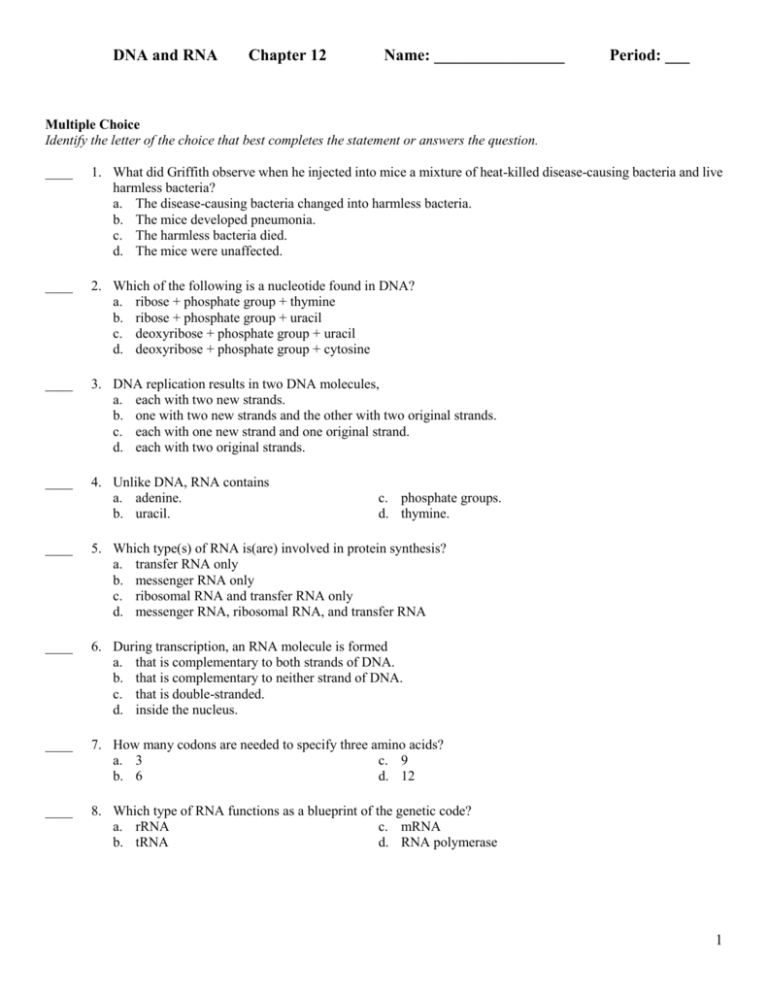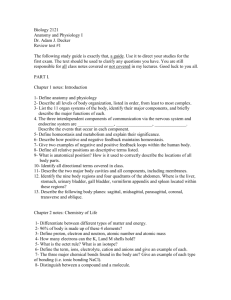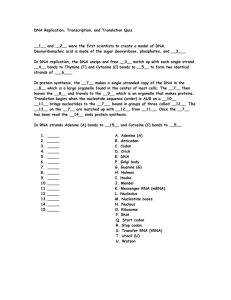DNA and RNA chapter 12 #1
advertisement

DNA and RNA Chapter 12 Name: ________________ Period: ___ Multiple Choice Identify the letter of the choice that best completes the statement or answers the question. ____ 1. What did Griffith observe when he injected into mice a mixture of heat-killed disease-causing bacteria and live harmless bacteria? a. The disease-causing bacteria changed into harmless bacteria. b. The mice developed pneumonia. c. The harmless bacteria died. d. The mice were unaffected. ____ 2. Which of the following is a nucleotide found in DNA? a. ribose + phosphate group + thymine b. ribose + phosphate group + uracil c. deoxyribose + phosphate group + uracil d. deoxyribose + phosphate group + cytosine ____ 3. DNA replication results in two DNA molecules, a. each with two new strands. b. one with two new strands and the other with two original strands. c. each with one new strand and one original strand. d. each with two original strands. ____ 4. Unlike DNA, RNA contains a. adenine. b. uracil. c. phosphate groups. d. thymine. ____ 5. Which type(s) of RNA is(are) involved in protein synthesis? a. transfer RNA only b. messenger RNA only c. ribosomal RNA and transfer RNA only d. messenger RNA, ribosomal RNA, and transfer RNA ____ 6. During transcription, an RNA molecule is formed a. that is complementary to both strands of DNA. b. that is complementary to neither strand of DNA. c. that is double-stranded. d. inside the nucleus. ____ 7. How many codons are needed to specify three amino acids? a. 3 c. 9 b. 6 d. 12 ____ 8. Which type of RNA functions as a blueprint of the genetic code? a. rRNA c. mRNA b. tRNA d. RNA polymerase 1 DNA and RNA ____ Chapter 12 Name: ________________ Period: ___ 9. Which of the following is NOT a gene mutation? a. inversion c. deletion b. insertion d. substitution ____ 10. A lac repressor turns off the lac genes by binding to a. the promoter. c. the operator. b. tRNA. d. the lac genes. ____ 11. Which of the following statements is NOT true? a. Mutations do not occur in hox genes. b. Hox genes that are found in different animals are very different from each other. c. Hox genes control the normal development of an animal. d. Hox genes occur in clusters. True/False Indicate whether the sentence or statement is true or false. If false, change the identified word or phrase to make the sentence or statement true. 12. The structure labeled X in Figure 12-1 is Hydrogen bond between Cytosine and Guanine.___________ Figure 12–1 13. The order of nitrogenous bases in DNA determines the order of Amino Acids in proteins.____________ 14. There is no triplet codon that is specified by a stop codon on an DNA molecule._____________ 15. DNA polymerase reads the triplet codon on both strands in the same direction during replication. ___________ 16. Transcription occurs within the nucleus. _______________ 2 DNA and RNA Chapter 12 Name: ________________ Period: ___ Short Answer: Use complete sentences to answer the following 5 questions, one of which must be question 24. 17. At the beginning of DNA replication, what must occur in order for the two strands of a DNA molecule to separate, explain? (2) 18. What Function does the molecule tRNA complete, explain this function in detail? (4) 19. Describe the Hershey-Chase experiment. Why were the results important? (4) 20. Describe the structure of a DNA molecule. (3) 21. Contrast the functions of the three main types of RNA, mRNA, tRNA, and ribosomal RNA. (6) 22. Why do some kinds of point mutations cause greater changes in proteins than others? (3) 3 DNA and RNA Chapter 12 Name: ________________ Period: ___ 23. USING SCIENCE SKILLS (1 mark each) Figure 12–4 a. Interpreting Graphics What process is illustrated in Figure 12-4? b. Interpreting Graphics Identify structure C in Figure 12-4. c. Interpreting Graphics Which labeled structure in Figure 12-4 is a codon? d. Inferring What is the relationship between the codons and anticodons in Figure 12-4? How is this relationship important? e. Predicting In Figure 12-4, what will happen after the ribosome joins the methionine and phenylalanine? 4 DNA and RNA Chapter 12 Name: ________________ Period: ___ 24. Using the original strand of DNA material below, complete the following processes. Replication, Translation andTranscription, ATGAGAAGTAGGAGAAGCATAATCGATTCAACACATCCAGCCACATTAG Explain how each of the above processes (Replication, Translation and Transcription) occurs in the cell. This question requires DETAIL. (12) __________________________________________________________________________________________ __________________________________________________________________________________________ __________________________________________________________________________________________ __________________________________________________________________________________________ __________________________________________________________________________________________ __________________________________________________________________________________________ __________________________________________________________________________________________ __________________________________________________________________________________________ __________________________________________________________________________________________ __________________________________________________________________________________________ __________________________________________________________________________________________ __________________________________________________________________________________________ __________________________________________________________________________________________ __________________________________________________________________________________________ __________________________________________________________________________________________ __________________________________________________________________________________________ __________________________________________________________________________________________ __________________________________________________________________________________________ __________________________________________________________________________________________ __________________________________________________________________________________________ __________________________________________________________________________________________ __________________________________________________________________________________________ __________________________________________________________________________________________ __________________________________________________________________________________________ __________________________________________________________________________________________ __________________________________________________________________________________________ __________________________________________________________________________________________ __________________________________________________________________________________________ __________________________________________________________________________________________ __________________________________________________________________________________________ 5 DNA and RNA 25. Chapter 12 Name: ________________ Period: ___ Describe the relationship between DNA, Chromatin, histones and nucleosomes. (3) 6 DNA and RNA Chapter 12 Name: ________________ Period: ___ DNA and RNA Answer Section MULTIPLE CHOICE 1. 2. 3. 4. 5. 6. 7. 8. 9. 10. 11. ANS: ANS: ANS: ANS: ANS: ANS: ANS: ANS: ANS: ANS: ANS: B D C B D D A C A C B REF: REF: REF: REF: REF: REF: REF: REF: REF: REF: REF: p. 288 p. 291 p. 299 p. 300 p. 300 p. 301 p. 302 p. 301 p. 308 p. 310 p. 312 COMPLETION 12. ANS: nucleotide REF: p. 294 13. ANS: amino acids REF: p. 302 14. ANS: amino acid REF: p. 303 15. ANS: lactose REF: p. 310 16. ANS: enhancer REF: p. 311 SHORT ANSWER 17. ANS: The hydrogen bonds between the base pairs must be broken and the molecule must unwind. REF: p. 299 18. ANS: Molecule B is tRNA, which carries amino acids to the ribosomes. REF: p. 301 19. ANS: Lactose binds to the lac repressor, causing the repressor to release the operator. 7 DNA and RNA Chapter 12 Name: ________________ Period: ___ REF: p. 310 ESSAY 20. ANS: Hershey and Chase grew bacteriophages in cultures containing radioactive isotopes of 32P and 35S. The 32P became incorporated into the bacteriophage’s DNA because DNA contains phosphorus. The 35S became incorporated into the bacteriophage’s protein coat because proteins contain sulfur. After the bacteriophages were allowed to infect bacteria, Hershey and Chase found that nearly all the radioactivity in the bacteria was from 32P. This indicated that the bacteriophage’s DNA was injected into the bacteria. The results were important because they showed that the bacteriophage’s genetic material was DNA, not protein. REF: p. 289, p. 290 21. ANS: A DNA molecule has the shape of a double helix, or that of a twisted ladder. Each strand of the helix is a chain of nucleotides. Each nucleotide is made up of a deoxyribose sugar, a phosphate group, and a nitrogenous base. The two strands are held together by hydrogen bonds between the nitrogenous bases of the nucleotides on opposite strands. The nitrogenous bases form hydrogen bonds with each other in pairs. Adenine forms hydrogen bonds with thymine, and guanine forms hydrogen bonds with cytosine. REF: p. 294 22. ANS: Messenger RNA carries copies of instructions for assembling proteins from DNA to the ribosomes. Ribosomal RNA is a component of the ribosomes. Transfer RNA carries amino acids to the ribosomes for assembly into proteins. REF: p. 301 23. ANS: Proteins have many different functions in an organism. These functions include catalyzing and regulating chemical reactions, regulating growth patterns, and providing the actual structural components of the organisms. Together, these functions play a key role in producing an organism’s traits, or phenotype. REF: p. 306 24. ANS: Point mutations include substitutions, insertions, and deletions of single nucleotides in DNA. Insertions and deletions have a greater effect on proteins than do substitutions, because insertions and deletions change the reading frame of the genetic code, affecting every amino acid that follows the point of mutation. In contrast, a substitution affects a single amino acid. A change in more than one amino acid is more likely to alter the function of the protein than is a change in a single amino acid. REF: p. 307 OTHER 25. ANS: Translation (or protein synthesis) is illustrated. REF: p. 304 8 DNA and RNA Chapter 12 Name: ________________ Period: ___ 26. ANS: Structure C is a ribosome. REF: p. 304 27. ANS: Structure F is a codon. REF: p. 302 28. ANS: The codons and anticodons have complementary nitrogenous bases, allowing them to base pair. Since each tRNA carries only one kind of amino acid, the base pairing between the anticodons and codons brings a specific sequence of amino acids to the ribosomes. REF: p. 304 29. ANS: The bond between the methionine and its tRNA will be broken. The tRNA will move away from the ribosome, allowing the ribosome to bind with another tRNA. The ribosome will move down the mRNA to the next codon. REF: p. 304 9






